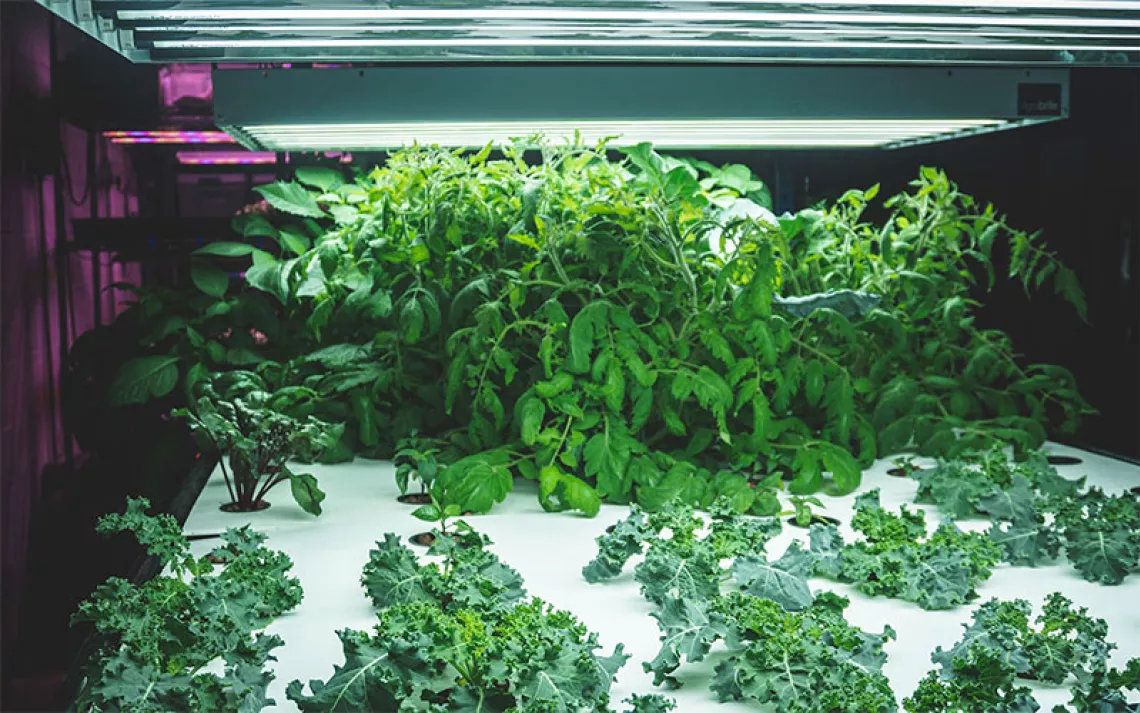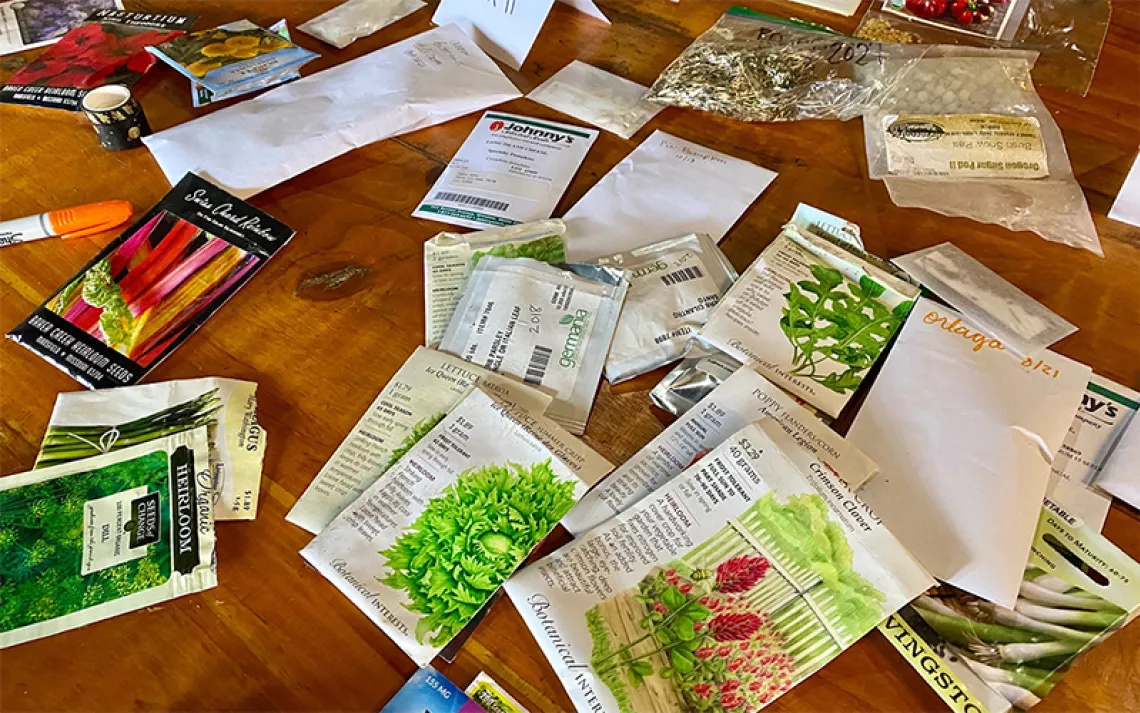Up on the Farm
Two models for rooftop agriculture vie to feed the Big Apple

The view from Brooklyn Grange's rooftop garden. | Photo by Cyrus Dowlatshahi
TO VISIT BEN FLANNER'S FARM, take the R train to 36th Street in Queens. Climb to the street, escaping the subway breeze that smells like hot iron, and walk two blocks east on Northern Boulevard. Enter a nondescript six-story office building. In the elevator, push the R button for "roof." After the bald guy with a briefcase steps off on floor three, wait for the doors to slide open again. You will be met by a disorienting burst of sunshine and a view of the Triborough Bridge, and your best New York don't-mess-with-me scowl will be directed at a lovely row of eggplants.

Ben Flanner of Brooklyn Grange. | Photo by JJ Sulin
The Brooklyn Grange has neither desk nor receptionist—just a sign saying that no dogs are allowed and that it is unwise to approach the bees. Three interns, browned by the summer sun, pick chamomile flowers for tea. Sunflowers strain to peek over a low border wall. To the west, the Manhattan skyline shimmers in the heat.
I'm looking for Flanner, the Grange's head farmer and president, but the interns say he isn't in yet, so I admire the neat raised rows of peas and peppers. The farm is 40,000 square feet, one of the largest rooftop farms in the United States. It's part of a rapidly growing movement of people who believe that urban agriculture can help absolve New York and cities everywhere of their environmental sins.
Everyone knows that New York is full of foodies, but few realize that it is also full of farmers. City farmsteads are cropping up all over, and New York has more of them—and more on rooftops—than anywhere else. In addition to at least 7 rooftop enterprises, there are 17 ground-based farms in the Big Apple and 1,000-plus community gardens, far more than in any other American city.
Growing food in a city's dense core, urban farmers say, can turn back the diesel-chugging trucks hauling salad mix across the country, lower energy bills by replacing hot black-tar roofs with cool greenery, slim waistlines by supplying bodegas with fresh-picked tomatoes, and let children reared on concrete learn the joy of yanking a carrot from the soil.
Flanner jogs toward me. "Sorry I'm late," he says with a grin. Rangy and wearing running shoes, he sports a four-day beard, shorts, and a T-shirt that, while clean, will never be white again. "Let me give you the tour." He's barely started explaining the irrigation system when we're interrupted by a visiting delegation of women from Bangladesh, Thailand, and China. Next, a colleague approaches with some emergency involving the produce stand in the lobby downstairs. Crisis resolved, at last he's able to tell me where the farm sends its dozens of varieties of herbs and vegetables: a third goes to farmers' markets (where it quickly sells out), a third to customers who subscribe to its community-supported agriculture program, and the rest to high-end restaurants.
In case things aren't busy enough, the Grange is laying the soil for a second, 45,000-square-foot rooftop farm at the Brooklyn Navy Yard. Other endeavors include New York's biggest apiary, also at the Navy Yard, with about 30 hives, and an indoor experiment cultivating shiitake mushrooms. Groups from all over the world request training seminars, and a new nonprofit foundation handles the squads of schoolchildren who visit each week. Flanner points out a table built to seat 60, the centerpiece of yet another of the Grange's sideline businesses: hosting dinners, photo shoots, and weddings.

Viraj Puri of Gotham Greens. | Photo by JJ Sulin
"We all wear many different hats, and we're involved in many different things," Flanner says as he adjusts a sprinkler that's irrigating a row of arugula.
An engine of the farm's success—and one reason it turns a modest profit—is its dozens of interns and small army of volunteers, mostly apartment dwellers who yearn to plunge their hands into dirt. "It's critical to our business that the community is as involved as possible," Flanner asserts. With their help, the Grange was able to spread 1.2 million pounds of soil without an earthmover. Building a farm in the middle of the densest city in the country gives these unpaid laborers an eclectic list of skills for their resumes: real estate developer, regulation wrangler, structural engineer, and entrepreneurial problem-solver.
While we talk, Flanner pulls out a tube of sunscreen and slathers some on his neck. Today is the longest day of the year and the beginning of a wicked heat wave that will see the heat index reach 105 degrees. From up here, it's clear why: the black-tar roofs in every direction that soak up the sun and raise temperatures in New York by as much as 7 degrees higher than in the surrounding countryside.
I point out a head of winterbor kale bobbing in the breeze next to an HVAC unit. "It's a reminder that this green roof is reducing the time that those run," Flanner says, bending down to pull a weed from a row of habaneros.
FLANNER, 31, QUIT HIS JOB AT E-TRADE three years ago because he wanted to try his hand at farming. Still, he didn't want to give up his cosmopolitan lifestyle. He hands me a bag of mixed greens and waits expectantly for my judgment. They are fresh and tangy, the result of a special lightweight soil called Rooflite, made from mushroom compost and mineral aggregates, that's been dressed with the farm's own compost.
"Our leaves change with the weather, the compost, and the nature of the soil, which creates surprises. That's all really exciting for the chefs and the people who appreciate our produce," Flanner says. Among that number is Lois Burnett, general manager of MoMo Sushi Shack, who garnishes dishes with the Grange's microgreens. "The experience has been fabulous," she says. "The produce is really fresh, and we definitely like to talk about it [to our customers]."

Hydroponic, computerized Gotham Greens. | Photo courtesy of Gotham Greens/Ari Burling
A recent survey by Columbia University determined that 3,079 acres of public and private buildings in New York have rooftops that are big and flat enough to support urban agriculture. Most of these are in the Bronx, Brooklyn, and Queens. (Supplying all of New York's temperate fruits and vegetables would require 232,000 acres—an area larger than the city itself.) Onions, beans, and grains are poorly suited to urban growing, but rooftop farms could contribute a modest portion of New York's leafy greens, herbs, and vine crops like tomatoes and cucumbers.
Unless, of course, someone figured out how to grow a whole lot more food in the middle of the city in some other way.
Flanner knows where my next stop is. "Don't count dirt out," he pleads. "There's a lot to be said for dirt."
The next day is even more sweltering, and I arrive at Gotham Greens in the hottest part of the afternoon. This farm is in a desolate industrial stretch of Brooklyn near a wastewater-treatment plant. Unlike the Grange, it can be seen from the street—a greenhouse peeping over the roofline.
I walk up three flights of stairs and directly into a transparent 15,000-square-foot structure that is crowded with lush lettuce, cilantro, and parsley. No one is there. My sweat glands were bracing for the greenhouse effect, but somehow it seems a few degrees cooler than outside.
I yell hello and roust Viraj Puri, Gotham's 31-year-old CEO, who is there by himself after sending his 20 workers home because of the heat wave.
In contrast to my visit to the Grange, this interview is all efficiency. There are no interruptions. Puri explains how sensors located all over the greenhouse track temperature, humidity, carbon dioxide, oxygen, and light levels. "All that information is fed back to a computer-controlled system, which is programmed to turn on and off to achieve the climate conditions that we desire."
There is a slight breeze created by two fans whirring overhead and vents in the ceiling and the walls, which the computer has wisely chosen to open. A layer of fabric has been drawn like a curtain over the ceiling to filter the sunlight. The Gotham model is all about control—over the building, crops, and visitors.
Puri has brown eyes and a square jaw, and his white button-down shirt shows not a speck of dirt. The entire facility, in fact, is spotlessly clean and meticulously organized, which perhaps is not surprising for an enterprise looking to create prodigious amounts of food without using soil.

Sign up to receive Sierra News & Views
Get articles like this one sent directly to your inbox weekly.
With this action you affirm you want to receive Sierra Club communications and may vote on policy designated by the Sierra Club Board.
The key is hydroponics. Along one wall are propagation trays, where buds of basil sprout from minuscule cubes of rockwool, a material made from superheated basalt. After a few days, the shoots are transferred to long white plastic trays, where they are fed by a stream of constantly recirculated water mixed with powdered nutrients like nitrogen, phosphorous, and potassium.
"Crops don't technically need soil to grow," Puri explains. "What they need is oxygen, CO2, sunlight, water, and nutrients, and we're able to provide it all right here to ensure really consistent yield, very healthy crops. And we don't contend with many of the issues that conventional farms face."
The greenhouse is as peaceful as a meditation center, attended by the faint sound of splashing water. The trays are perfectly aligned, and black tubes feed them at nearly identical vectors. Jenn Nelkin, the head grower, is a hydroponics expert who once grew cucumbers and bell peppers at the McMurdo research station in Antarctica.
IF GOTHAM'S APPROACH LACKS THE RURAL ROMANCE of dirt farming, there's no arguing with its results. In its first year of operation, Puri says, the facility grew 120,000 pounds of produce—three times more than the Grange, in about a third of the space. That's partly because during the winter, while the Grange lies fallow, Gotham keeps growing, aided by high-pressure sodium lights and a 55-kilowatt solar array that creates half the power the greenhouse needs throughout the year.
Puri guides me toward a bank of butter lettuce, packed as densely as subway passengers but healthier-looking. He extracts a head. It trails a beard of tangled and ghostly white roots, which grow smaller than they would in soil because the plant needn't strain for its dinner.
He pulls off a leaf. It's one of the most tender bits of lettuce I've ever tasted.
"It's not dealing with rain, it's not dealing with hail, it's not dealing with wind, it's not dealing with huge temperature swings," Puri says. And unless the growers alter its powdered rations, Gotham's butter lettuce will taste exactly the same year after year.
That head of lettuce sells for $3.99 at Whole Foods in Union Square. Gotham is focusing on supermarkets, where volume and consistency are required. Puri says the company expects to close the deal soon on two new rooftop facilities in New York of 50,000 to 60,000 square feet each, one likely for greens and the other for vine crops. BrightFarms, another hydroponic company based in Manhattan, is breaking ground on a monster 100,000-square-foot urban greenhouse nearby and has contracts with supermarkets in Oklahoma, Pennsylvania, and elsewhere that will be supplied from local greenhouses, guaranteeing freshness and eliminating transportation costs.
The next step in the evolution of urban agriculture may be vertical farms, multistory greenhouses illuminated by a combination of sunshine and artificial light. If built on a sufficient scale, they could make a sizable contribution to the world's food supply. Stackable farms are already up and running in Korea, Japan, Singapore, and Chicago.
One threat to the uniformity of hydroponics is that disease in one plant can quickly infect an entire crop. To avoid spreading pathogens, says Dickson Despommier, a vertical farming specialist and a professor at Columbia University, workers might be required to shower and don sterile uniforms before reporting to the grow room.
Gotham Greens' single-story facility isn't that rigorous—it has roughly the same sanitary standards as a commercial kitchen—but it does strictly limit its visitors. A hydroponic farm can grow lots of produce, but it will never be a place where just anyone can lend a hand.
Which model will prevail, Gotham or Grange? I can't help thinking that Gotham has the upper hand. It's easy to imagine enormously productive, industrial-scale greenhouses multiplying across America's roofscapes like so many Walmarts, feeding far more people than the quirky, community-friendly farm over at the Grange ever will.
But I hope that every city gets the chance for a Grange or two, where fairytale eggplants take root above the mad traffic, and the office drones know that rows of sunflowers nod just overhead.
 The Magazine of The Sierra Club
The Magazine of The Sierra Club



